The History of the Genericization of Tea Party Shoes
Have you ever seen someone say they are looking to buy some TPS or Tea Party Shoes, but they don’t care what brand made them? Or perhaps someone is showing you a pair of lolita Mary Janes from an indie brand and they call them Tea Party Shoes. Perhaps you yourself do this.
But why are they all Tea Party Shoes?
It’s not because they are the shoes people most commonly wear to tea parties, or anything else of the sort. Using TPS to mean “lolita mary jane flats” is a genericization of a specific Angelic Pretty item name. Genericization is the process where a term (usually a trademarked one, but not always) that is specific to a brand replaces the generic term for an item. For example, did you photocopy the paper, or did you xerox it? Did you digitally edit the photo, or did you Photoshop it? Did you get the teacher a box of tissues, or kleanex?
Brands really don’t like when their trademarked terms become genericized because it can cause confusion and erode people’s faith in their product if people think an inferior or faulty product is made by the brand. Genericization can also sometimes allow competitors to use terms that were previously considered trademarked, and makes it harder for brands to fight against knock offs.
So, let’s back up, what exactly is a Tea Party Shoe?
This is Angelic Pretty’s original Tea Party Shoe.
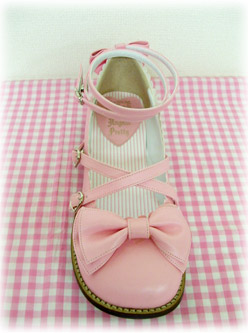
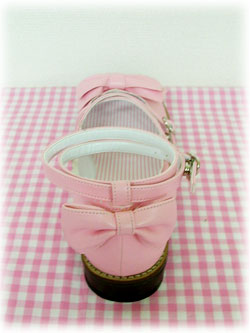
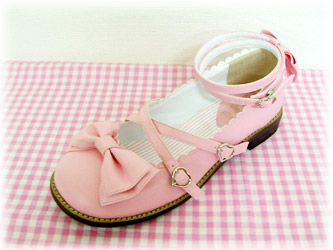
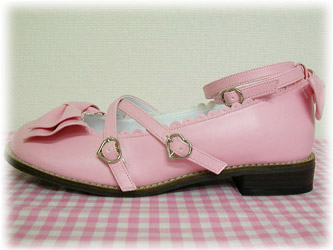
The oldest entry for this shoe in lolibrary is 2005, and I believe this is the first release of the shoe. I believe these would have been designed by Asuka who joined Angelic Pretty in 2001.
Though I did say the genericization of the name had nothing to do with them being the shoes people wear to tea parties, they were named with that in mind. The sales text did basically say “These are the shoes for you when you think ‘Yes, I want to go out to tea party ♪'”.
The shoes were a hit and quickly became a staple item for Angelic Pretty, getting released over and over, with new colors constantly joining the mix. Staple items are important to small brands because they allow the brand to continue to get sales without investing in the research and design work of making a whole new item from scratch.
But, something happened. Very quickly, we started to see people making 1:1 copies of these shoes as closely as possible. Now, this is legal, but, perhaps not particularly ethical.
Secret Shop, a brand that takes pre-orders until they have enough to do a run of a replica shoe, an*tai*na which almost exclusively makes knock off shoes, Sosic shop and several other stores popped up offering replica Tea Party Shoes. There were requests for where to buy them as early as 2006 on LJ. Buying replica shoes on EGL was so common, that one of the main shopping services would run polls on what shoes to start group orders with Secret Shop on. This continued until around the time the EGL policy on replicas changed. By that point, it was taking more than a year to meet the minimum for a knock off pair of shoes, and with shifting opinions on knock offs, some of those people who had pre-ordered secret shop shoes didn’t want them anymore by the time they finally went into production.
I will say that people anecdotally have said in old threads that they didn’t think the AP designers recognized fakes, but I’ll also say that I was told a story from someone in the industry that they do, and were quite upset when they first heard of them. So, there is that.
Anyways, over the years people started talking about their Secret Shop Tea Parties, and their An*Tai*Na Tea Parties or their shoes from an*tai*na (TPS style), in the same sort of way that people used to talk about “Bodyline Fruits Parlor” or “OoJia Toy March”. Everyone knew that the ones that weren’t AP were knock offs… until enough new people came into lolita that… some people didn’t.
Some people’s quest to find the same shoe style only cheap, and the influx of new lolita who didn’t realize the TPS that weren’t from AP were non-print replicas led to the term being applies to other shoe styles, like this pair of Metamorphose shoes, which oddly enough isn’t the shoe that Meta sells that is most similar to AP’s Tea Party Shoe, which is their Cross Strap Mary Jane Shoes with Ribbon.
The Meta shoes have an extra detail across the toe box, a different edging design, an extra bow and different construction. They are basically “two brands ended at the same idea”, unlike the AP TPS knock offs which are made to be as close as possible.
How close are the intentional copies?
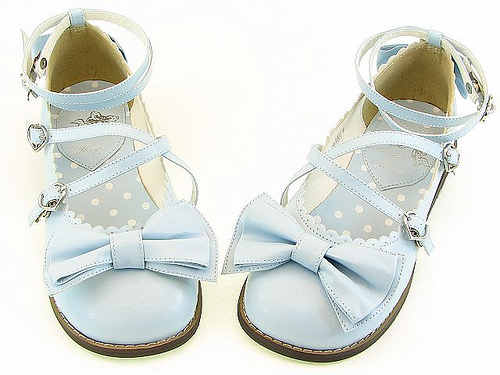
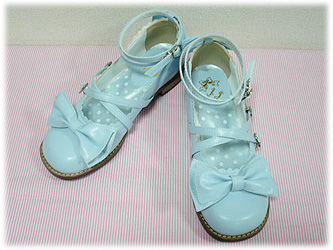
Here is a pair of Secret Shop Tea Party Shoe Replicas (left) and the AP shoes they are knocking off (right). Note that the insole is polkadot, something that most of the modern TPS shoes have, and it’s matched to the shoe upper. There is a heart inside the insole. It has a bow logo in the hear in gold, and now, some secret shop shoes say secret shop where the AP ones say AP, but I have seen fake AP shoes that say Angelic Pretty. The sole comes out past the toe box, with that surface stitching, they both use heart buckles, they have the same type of double bow… it’s very hard to tell them apart at first glance other than the color difference, which may be the photos.
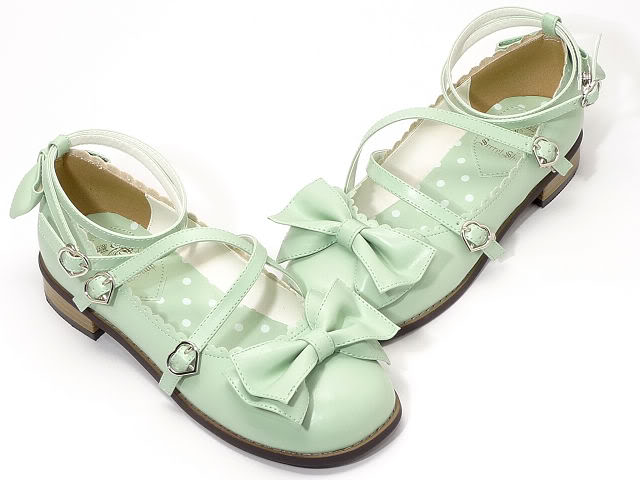
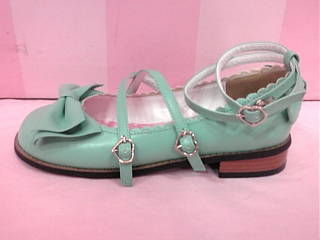
Even the faux wood pattern on the heel is copies, along with the heel height. Though, you might notice that the insoles aren’t a perfect match here. That’s because around the time this mint shoe was made (2009) AP was changing their insoles around a little, we saw some where one color didn’t follow the same pattern as other colors or one color would randomly have stripes. There wasn’t much rhyme or reason to the changes, and I’m not sure if they just couldn’t get material in the color they wanted for the insoles or something like that, or if it was really an active attempt to make it harder for copies to be made.
Tips For Buying Second Hand to Avoid Being Ripped Off
This means that when you are trying to decide if a second hand shoe is legitimate Angelic Pretty or if it’s a fake being passed off as real AP at AP prices, the very first thing you want to do, is look for that Angelic Pretty insole. No AP insole? It’s 100% certain to not be Angelic Pretty. If there is an AP insole, then you have to do a bit more detective work, and carefully compare to photos of the legit AP shoes. Frequently, with copies, the front bow will be a little off, or the combination of insole heart, insole logo and insole pattern/color won’t match up, but for some colors like pink, it’s harder because the legitimate shoes tend to exist in most combinations.
If you need help, try a group like big sisters or what is that dress to request photos of a legitimate pair of shoes in the same style.
Now, most sites do allow legal (design) replicas like shoe replicas to be sold, so if someone is selling a secret shop shoe and calling it a secret shop shoe, that’s typically permitted. But, if someone is selling a secret shop shoe and trying to pass it off as legitimate AP or something similar, and you have solid proof, do contact a moderator about it, but I would urge caution not to be overzelous, lest mistakes be made. After all, some of the fakes are very close. My goal here is not to inspire people to go checking every second hand sale of AP shoes, but instead to bring awareness and help people make informed decisions for their own purchased.
Lastly if it seems to good to be true, it probably is. Second hand brand shoes that are suspiciously cheap on Japanese auction usually have damage or if they are totally new, they might be B-grade pieces that were sold off as B-grade / in lucky packs. Fakes are more likely to be in circulation outside of Japan, but it’s not impossible for them to be in circulation in Japan. Look at the seller’s reviews and double check the listing details before buying.
Why I personally don’t use TPS as a generic name
Because the genericization of TPS started with replicas, which were upsetting to the designers, I personally don’t like to use the term TPS for Mary Jane flats made by other designers. Not only is it a little bit weird to me as a lolibrarian (it’s kind of like calling all fruit prints fruits parlor, or all basic JSKs “Shoulder Ribbon JSK”), it feels disrespectful to both designers.
AP designed a specific shoe and they gave it a specific name. So did other designers. Indie designers and other designers like the designers of Meta deserve credit for their designs and they deserve to have their designs called by the proper name instead of using another brand’s term for an item that is more popular. It kind of feels like a snub to me. Like, it feels like I’m saying, I didn’t bother to learn the name of your shoe, I’m just calling it “close enough to a specific AP shoe that it works as a stand in if I can’t get that specific AP shoe”.
So, while I fully understand what people mean when they say TPS or Tea Party Shoe and then show something that… isn’t a tea party shoe, I just personally can’t get behind it. It’s like calling a digimon a pokemon to me. It just feels off.
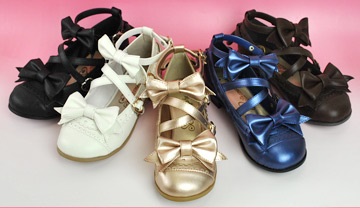
100% with you there. It irks me and rubs me wrong in the same way as you described. With maybe an added layer of “people who are so casual about design names could be more likely to not make effort to use people’s proper/preferred names”, which is a very big thing for me. I’m not even the most severely affected, but I do get my name routinely mispronounced and make effort to not to that to others. It takes exactly the same effort as it does to say “tea party shoes” and “lolita flats” or “lolita Mary Janes”, so when people don’t make that effort and it’s not out of ignorance, it’s disappointing at best.